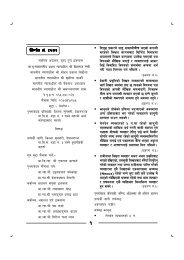The Nepali Judiciary - Supreme Court Of Nepal
The Nepali Judiciary - Supreme Court Of Nepal
The Nepali Judiciary - Supreme Court Of Nepal
Create successful ePaper yourself
Turn your PDF publications into a flip-book with our unique Google optimized e-Paper software.
listing achievements obtained from the Plan and also in identifying the problems and challenges<br />
encountered during the implementation of the Plan. <strong>The</strong> Plan with regards to judicial process and<br />
strengthening the judiciary has initiated the concept of planned development process and has<br />
been able to introduce new thoughts and concepts. This has created a foundation for the future of<br />
the judiciary. On the basis of this foundation and in order to give continuity to the process of<br />
planned development this Plan has been formulated.<br />
Strategic plan is a plan consisting of strategies deemed necessary for obtaining its designed<br />
destination through the application of management skills and limited resources. Strategic plan<br />
envisages the desire of change and also the potential changes in the external environment thereby<br />
assisting in achieving its target. <strong>The</strong>refore, this is different from the general plan or long-term plan.<br />
Scattered efforts are integrated in the strategic plan and the strategic plan determines the result<br />
and indicators and guides the organization to a definite target and emphasizes in obtaining the<br />
target within the prescribed period. Strategic plan is a guideline, which confronts adverse<br />
conditions and minimizes risks and recognizes the application of alternative remedies for reaching<br />
its target.<br />
<strong>The</strong> success or failure of the Plan of the <strong><strong>Nepal</strong>i</strong> judiciary depends upon the role of other parties.<br />
Provided, sufficient assistance and coordination cannot be established with the concerned<br />
stakeholders, it would not be possible for the Plan to achieve its desired result. A strategic plan is<br />
formulated within the limitation of one’s organization and within the limitation of work that can be<br />
implemented but this is not so with regards to the judiciary. <strong>The</strong> work and nature of the judiciary is<br />
such that activities of the judiciary should be implemented in cooperation and participation with the<br />
external stakeholders. <strong>The</strong> plan of the judiciary is not sufficient in itself to obtain its end result. For<br />
achieving the targets set by the Plan, positive and active participation is required from the<br />
Executive, Bar, government attorney, police, Judicial Council, National Judicial Academy,<br />
university, law faculties, media and civil society or from their representatives. <strong>The</strong>se organizations<br />
should also formulate strategic plans wherein those plans should coordinate with the plan of the<br />
judiciary and provided both plans are implemented simultaneously then only can we achieve the<br />
expected results. Looking back at the implementation of the first Plan, there was no coordination<br />
with other agents or actors. It has been experienced that reform plan should not only be reform<br />
plans of the judiciary but such plans should also address reforms of other concerned organizations<br />
related with the justice sector.<br />
Reformation of judicial process is a continuing process and judicial organization should<br />
continuously be involved in this process. <strong>The</strong> strategic plan followed by the judiciary is a result of<br />
such continuity. Provided, if we are to implement the plan with the concept of resolving all the<br />
problems at one go then such actions becomes immature and impractical. Every plan has issues<br />
that can be learnt upon. <strong>The</strong> experiences and weaknesses gained during the implementation of the<br />
past plan can be guidelines for future plans and with this principle a situation analysis has been<br />
carried out and effort towards formulating the basic features of the Plan has been presented.<br />
1.2 Plan Formulation Committee<br />
In order to provide formality to the formulation process of the second strategic plan, the<br />
recommendation made by Plan Formulation Committee on 2066 Baisakh 22 was ratified by High-<br />
Level Direction Committee on Baisakh 28, 2066, wherein the following committees were<br />
established.<br />
4




![lg0f{o g+=&(&# g]=sf=k= @)^% ;af]{Rr cbfnt ljz]if Ohnf; ;DdfggLo k ...](https://img.yumpu.com/10045627/1/190x245/lg0fo-g-gsfk-afrr-cbfnt-ljzif-ohnf-ddfgglo-k-.jpg?quality=85)
![lg0f{o g+=&(@% g]=sf=k= @)^% ;jf]{Rr cbfnt, ljz]if Ohnf; dfggLo ...](https://img.yumpu.com/6479513/1/190x245/lg0fo-g-gsfk-jfrr-cbfnt-ljzif-ohnf-dfgglo-.jpg?quality=85)

![lgj]b s ljkIfL - Supreme Court Of Nepal](https://img.yumpu.com/5482729/1/190x245/lgjb-s-ljkifl-supreme-court-of-nepal.jpg?quality=85)